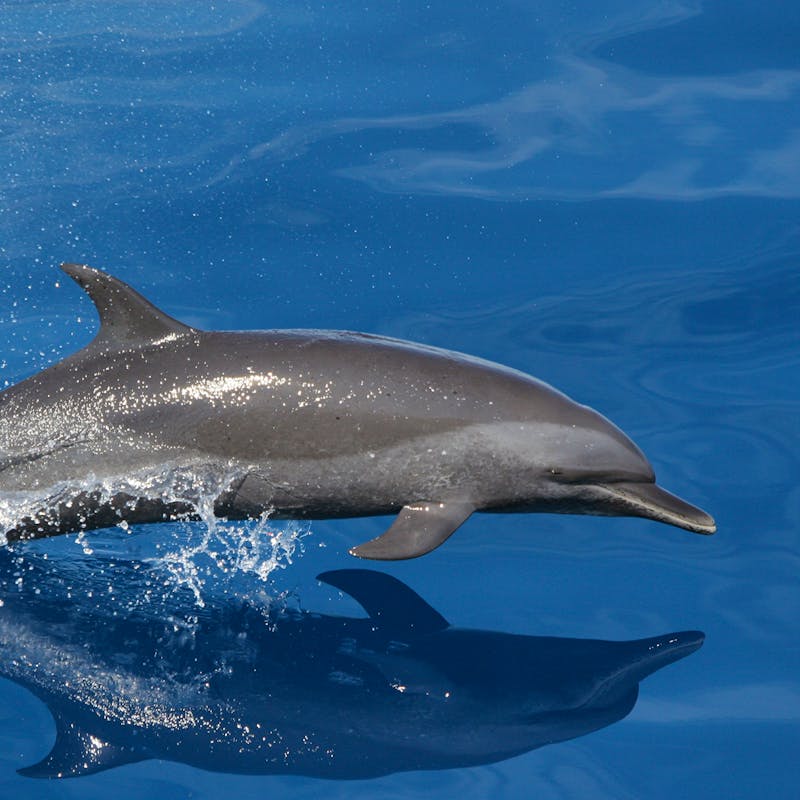Portuguese sailors named it sargaço, or “little grape.” It is better known regionally as Gulf weed, or the far more poetic sea holly. Sargassum is a seaweed that, when densely concentrated, functions as a biological oasis throughout the nutrient-poor, almost desert-like surface waters of the deeper stretches of the Gulf of Mexico. Much like a terrestrial oasis, the plants form the foundation of this unique ecosystem. Because of its significant role in providing food and shelter, marine scientists are paying close attention to Sargassum in the Gulf in order to assess the harm wrought by toxic oil spewing from the Deepwater Horizon spill.
Sargassum is a widespread genus of brown alga or seaweed. About 150 species occur throughout the temperate and tropical oceans of the world, where they inhabit shallow water and coral reefs. But the genus may be best known for its two planktonic (free-floating) species, S. fluitans and S. natans. These Sargassum live their entire life cycles in the surface waters of the open ocean, forming impressively large mats of vegetation. This vegetation provides crucial habitat for a wide variety of marine animals. These include economically important pelagic species such as tuna, dolphin, wahoo and billfish, as well as sea turtles and marine birds. Sargassum provides the shelter and food for the animal community. In turn, the animals’ waste products feed the seaweed with the nutrients it needs, like nitrogen and phosphorus. Such mutual (but delicately-balanced) relationships are what make Sargassum so vulnerable to exposure from oil.
Large aggregations of Sargassum, made up of many individual plants, are made possible because this plant has many branched stems containing hollow, berry-like floats. Hollow floats aid the plant in staying near the surface, which is necessary for photosynthesis, the process it uses to make food with energy from the sun. In fact, because Sargassum lives at the air-sea interface, where solar radiation is so intense, it has special adaptations for this energy production. Sargassum has flexible cellular adjustments for decreasing functional light absorption during the sunniest days, but then increasing light absorption on overcast days. Sargassum even contains its own sunscreen to guard itself from being scorched by the harsh UV light that is ubiquitous in the tropics and subtropics.
Whenever and wherever ocean currents are particularly favorable, Sargassum can collect into even larger patches or windrows. Favorable currents include shear zones, where one current is faster and/or at contrary angles to another, at convergence zones, where currents flow together and sink, and at wind-driven, helical vortexes of water arranged in parallel rows called Langmuir cells. At their very densest, the alga can be so concentrated that patches reach acres and acres in total size and pile up to 3 meters deep, giving one the impression of a virtual floating island in the middle of the ocean.
For many years, the exact origin or birthplace of the two pelagic Sargassum species was a mystery. Then, just a few years ago, Jim Gower and Stephanie King used satellite imagery to show that Sargassum is primarily “born” in the northwest Gulf of Mexico during the spring months. From here, it is transported through the Straits of Florida and out into the open Atlantic Ocean by about July. It then appears off Cape Hatteras, North Carolina before ending northeast of the Bahamas in February of the following year. Much to the surprise of many of us, including me,who long thought the Sargasso Sea was the birthplace for most of this alga, it is really the Gulf of Mexico that serves as the Atlantic’s Sargassum nursery.
How much Sargassum is there? And just how extensive is it in the Gulf of Mexico? Again, the answer comes to us from satellite photos. Under the most favorable conditions, Sargassum patches form what are essentially small islands. The Gulf of Mexico has immense quantities of this habitat. So much of it, in fact, that it appears spread over vast swaths and at incredible densities that are easily detected from space.
In this image, seaweed lines of Sargassum appear as light yellowish or greenish strands dispersed in miles-long patches throughout the entire Gulf of Mexico off Louisiana and Texas. This huge nursery, home to so many species of incredible fish, invertebrates, and marine vertebrates, is under direct attack from the Deepwater Horizon oil spill.
In the next entry, we’ll take a closer look at some of the marine creatures threatened by loss of irreplaceable Sargassum habitat. And we’ll rejoin biologist David S. Lee on his journey on the research vessel F. G. Walton Smith as it looked at Sargassum health in the eastern Gulf of Mexico.







